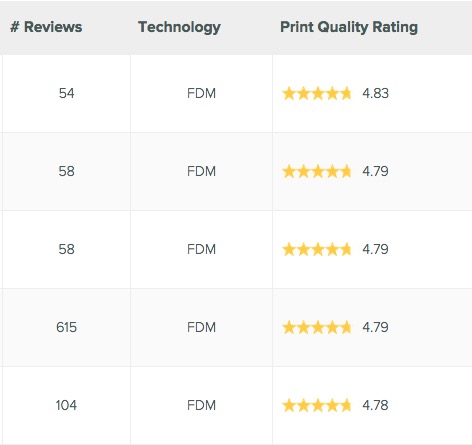
3D Hubs has issued its latest trends report on their view of 3D printer use. We noticed some interesting patterns.
3D Hubs publishes these reports every month, based on an analysis of the transactions taking place on their massive community network of 3D printer, which now exceeds 21,000 printers. This data is relatively independent of vendor bias, and so is often provides unusual insights into what’s really going on in the 3D printing community.
A key metric used by 3D Hubs is the print quality rating, as provided by the buyers of prints. By correlating this with the printer model, you might be able to see which machines produce the best output. But there’s a problem: on 3D Hubs’ latest list of desktop printer quality, the ratings are almost all the same! Out of a 5.00 possible perfect score, the top entry (Prusa Steel), shows 4.83, while the MakerBot Replicator 1 in 20th place ranks at 4.69. Only 0.14 points separate the top twenty machines! That’s only a 3% difference.
This suggests that contemporary desktop 3D printers may be hitting a performance and quality plateau.
Another interesting observation is the increased appearance of industrial 3D printers on various lists in the report. This suggests that 3D Hubs’ community is becoming a more popular option for those owning such expensive 3D printers. Perhaps in-house workshops with idle Stratasys or 3D Systems machines are hoping to make some extra revenue by offering their machines to the public through 3D Hubs?
The report also talks to the cities with the most participants. While there are obviously many 3D printers that are not in 3D Hubs database, the numbers are still large for some cities. The largest is New York City, where the report says are 336 participants. The interesting part is that this grew by 4.7% month over month, meaning some sixteen machines were added in August. That’s one every second day! Amsterdam, with 167 machines, is said to have “double digit” growth.
In total, 3D Hubs grew their network by over 1,000 machines in August. That’s a huge number for this non-mainstream industry, and tells us that others entering the community 3D printing network business will have a very difficult time matching those growth numbers, which are in all likelihood going to increase even more.
Via 3D Hubs

